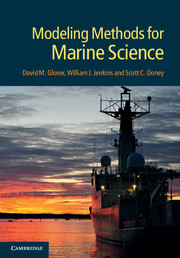Book contents
- Frontmatter
- Contents
- Preface
- 1 Resources, MATLAB primer, and introduction to linear algebra
- 2 Measurement theory, probability distributions, error propagation and analysis
- 3 Least squares and regression techniques, goodness of fit and tests, and nonlinear least squares techniques
- 4 Principal component and factor analysis
- 5 Sequence analysis I: uniform series, cross- and autocorrelation, and Fourier transforms
- 6 Sequence analysis II: optimal filtering and spectral analysis
- 7 Gridding, objective mapping, and kriging
- 8 Integration of ODEs and 0D (box) models
- 9 A model building tutorial
- 10 Model analysis and optimization
- 11 Advection–diffusion equations and turbulence
- 12 Finite difference techniques
- 13 Open ocean 1D advection–diffusion models
- 14 One-dimensional models in sedimentary systems
- 15 Upper ocean 1D seasonal models
- 16 Two-dimensional gyre models
- 17 Three-dimensional general circulation models (GCMs)
- 18 Inverse methods and assimilation techniques
- 19 Scientific visualization
- Appendix A Hints and tricks
- References
- Index
17 - Three-dimensional general circulation models (GCMs)
Published online by Cambridge University Press: 05 June 2012
- Frontmatter
- Contents
- Preface
- 1 Resources, MATLAB primer, and introduction to linear algebra
- 2 Measurement theory, probability distributions, error propagation and analysis
- 3 Least squares and regression techniques, goodness of fit and tests, and nonlinear least squares techniques
- 4 Principal component and factor analysis
- 5 Sequence analysis I: uniform series, cross- and autocorrelation, and Fourier transforms
- 6 Sequence analysis II: optimal filtering and spectral analysis
- 7 Gridding, objective mapping, and kriging
- 8 Integration of ODEs and 0D (box) models
- 9 A model building tutorial
- 10 Model analysis and optimization
- 11 Advection–diffusion equations and turbulence
- 12 Finite difference techniques
- 13 Open ocean 1D advection–diffusion models
- 14 One-dimensional models in sedimentary systems
- 15 Upper ocean 1D seasonal models
- 16 Two-dimensional gyre models
- 17 Three-dimensional general circulation models (GCMs)
- 18 Inverse methods and assimilation techniques
- 19 Scientific visualization
- Appendix A Hints and tricks
- References
- Index
Summary
People don't understand the earth, but they want to, so they build a model, and then they have two things they don't understand.
Gerard RoeSo far, we have introduced many of the elements of ocean modeling but in simplified situations with reduced dimensionality (i.e. box models, vertical 1D models, 2D gyre models). Here we pull all of the elements together, introducing the topic of 3D ocean general circulation models (GCMs). As you might expect, the topic is complex, and our GCM tour will be necessarily brief and focused. While you probably won't be able to construct your own GCM, you should at least be able to understand the conversation and perhaps even utilize 3D GCM output. Several good review articles and books have been written on ocean GCMs that the reader can refer to for more details (e.g. Haidvogel and Beckmann, 1999; Griffies et al., 2000; Griffies, 2004). While our emphasis is on marine systems, most of the fundamental concepts about GCMs are applicable to a wide range of environmental fluid systems, from the atmosphere to mantle convection to groundwaters.
Several themes emerge when considering ocean GCMs. First, no matter how fast technology develops, the cutting edge of ocean modeling is always “compute bound”, which is why you won't be able to build a decent GCM using MATLAB. Ocean GCM development is linked to the evolution of supercomputers, and in fact GCMs are commonly used to test new supercomputers.
- Type
- Chapter
- Information
- Modeling Methods for Marine Science , pp. 453 - 488Publisher: Cambridge University PressPrint publication year: 2011



